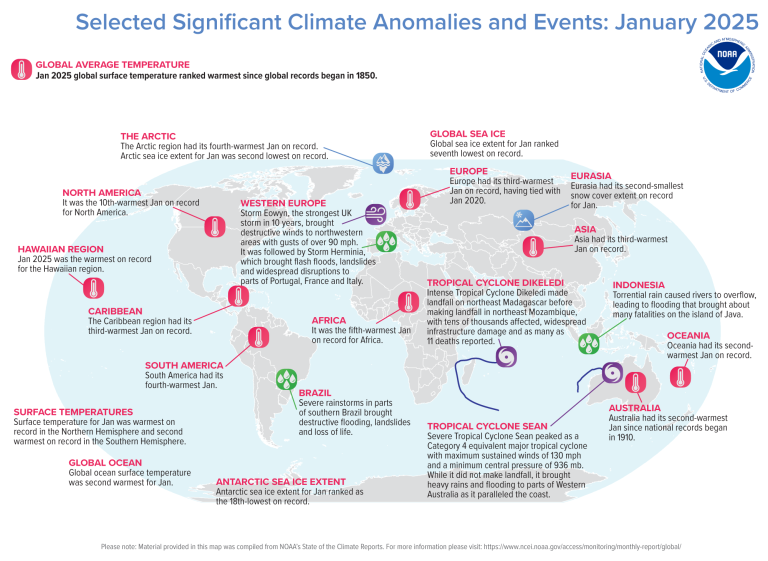The world just had its warmest January on record, according to leading international datasets from the Copernicus Climate Change Service and US National Oceanic and Atmospheric Administration.
The record heat occurred despite the emergence of a La Niña event, which normally has a temporary cooling effect. It was warmer than January 2024, when there was a warming El Niño event.
January 2025 was 1.75°C above the pre-industrial level, according to the Copernicus Climate Change Service (C3S), implemented by the European Centre for Medium-Range Weather Forecasts. It said that it was the 18th month in the last nineteen months for which the global-average surface air temperature was more than 1.5°C above the pre-industrial level.
Datasets other than ERA5 may not confirm this because of the relatively small temperature margins involved. Despite the slight differences in the datasets, all show that there has been an extended streak of record-breaking temperatures.
2024 was the warmest year on record, likely temporarily hitting 1.5°C for the first time, according to WMO's consolidated global analysis of six international datasets. A single year above 1.5°C does not mean that we have failed to meet Paris Agreement long-term temperature goals, which are measured over decades rather than an individual year.
However, it is essential to recognize that every fraction of a degree of warming matters.
The last ten years have been the ten warmest on record.
Temperature variations are not uniform. January 2025 temperatures were above average over much of the globe, but much below average over the United States, Greenland and far eastern Russia. Arctic sea ice extent in January was the joint lowest on record, according to C3S, and the second lowest according to NOAA .
The new January global record is particularly notable for having occurred during a La Niña episode. According to NOAA's Climate Prediction Center, La Niña conditions emerged in December 2024 and are expected to persist through February-April 2025.
WMO will issue its next El Niño/La Niña Update by the start of March.
Sea surface temperatures were above average over most areas, while much of the central and eastern tropical Pacific was below average (consistent with La Niña), as were parts of the southeast Pacific, western North Atlantic and the northwestern Indian Oceans. Global sea surface temperatures were the second highest on record for the month, after January 2024.

Precipitation
Areas of drier-than-average conditions covered much of the contiguous U.S. stretching south into Mexico and parts of Central America. Other areas with below-average precipitation included southeastern Europe through southwest and central Asia as well as parts of southeast Asia and the Russian Far East, and much of Australia.
In contrast, areas of wetter-than-average January conditions stretched from parts of western Europe to northeastern Europe through northwestern and central areas of Asia into eastern China and southeastern areas of Russia.
Several heavy rainfall events affected southern Brazil in January, leading to flooding, landslides, and widespread damage. In central Java, Indonesia, torrential rains caused rivers to overflow with flooding and landslides leading to reports of more than a dozen fatalities.
Five named storms occurred across the globe in January, which was below the average of seven. Three named storms formed in the southwestern Indian Ocean, the most impactful being Intense Tropical Cyclone Dikeledi, which made landfall on Madagascar and Mozambique, bringing high winds and heavy rains to the affected regions.






